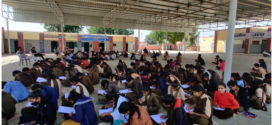Animation is one of the primary techniques used to improve the learning experience, and technology integration in education has grown in popularity in recent years. With its attractive visuals, interactive features, and capacity to captivate young learners, animation has become more popular in preschools as a useful instructional tool. Preschools are utilizing technology to improve the immersiveness, engagement, and effectiveness of the learning environment for young children through the use of animated material, setting them up for success in their educational journey. Through the right implementation and integration of animation in education, preschools can unlock the full potential of this innovative educational tool and provide young children with a strong foundation for lifelong learning.
Animation is a type of multimedia that blends images, sounds, and interactive elements to make learning more interesting and dynamic. Animated media is being embraced by preschools as a way to improve the educational experience for young children. We will explore in depth how preschools are benefiting from animation in education and the impact it is having on early childhood learning.
Preschools are gaining from the use of animation in education in the following ways:
1) Enhancing Learning Through Visuals:
As young children learn best visually, animation offers a rich visual experience that may grab their attention and inspire creativity. Preschools may use animated content to simplify difficult ideas and present them in a visually attractive way, which helps young children learn and retain information. For children, animation may bring abstract ideas to life and make them more relevant. Animation produces a visually appealing and immersive learning environment that may enhance early childhood learning experiences through colorful characters, dynamic imagery, and compelling stories.
2) Fostering creativity and imagination:
Animation is a creative medium that encourages children to think creatively and use their imagination. Preschools can use animated content to foster creativity and imagination in young children by exposing them to different styles of animation, characters, and stories. Animated content can inspire young children to create their own stories, drawings, and artwork, encouraging them to express themselves creatively. Animation can also stimulate critical thinking skills by presenting challenges, problems, and puzzles that young children need to solve, fostering their problem-solving skills and analytical thinking abilities.
3) Making learning fun and engaging:
One of the key benefits of using animation in education is that it makes learning fun and engaging for young children. Animated content can be designed to be interactive, allowing preschoolers to actively participate in the learning process. Through interactive elements such as quizzes, games, and activities, animation can make learning enjoyable, motivating young children to actively participate and stay engaged in the learning process. The use of animated characters and stories can also create an emotional connection with young children, making learning a more enjoyable and memorable experience.
4) Promoting Multimodal Learning:
Animation in education can promote multimodal learning, which involves the use of multiple senses such as sight, sound, and touch. Preschoolers can benefit from animation as it combines visual and auditory elements, providing a multi-sensory learning experience. Animated content can be accompanied by voiceovers, music, and sound effects that enhance the learning process and make it more engaging for young children. Moreover, animation can also incorporate interactive elements that allow preschoolers to interact with the content, further enhancing their learning experience through touch and movement.
5) Customizing Learning Experiences:
Animation allows for the customization and adaptation of content to suit the needs and interests of individual learners. Preschools can use animated content to tailor learning experiences to the specific needs of young children, catering to their interests, abilities, and learning styles. Animated content can be designed to be adaptive, allowing preschoolers to progress at their own pace and level of understanding. This personalized approach to learning can help young children build self-confidence, develop a love for learning, and progress at their own pace, ensuring that their unique learning needs are met.
To sum up, animation in education has become a potent instrument for preschools, offering young children a variety of advantages and expanding their learning opportunities. Animation provides preschoolers with a distinctive and comprehensive educational experience, from improving visual learning and promoting creativity to making learning entertaining and engaging. As technology develops, giving preschools creative and useful tools to improve the learning experience for young children. Preschools can also harness the power of animation in education by incorporating animated content into their curriculum, using educational animated programs and apps, and partnering with educational animation providers. Moreover, animation promotes parental participation, supports inclusion and diversity, invites customization, helps multimodal learning, and enhances language development.
(Sourav Mondal, Founder and CEO, Ssoftoons Entertainment, and Institute)
 Newspatrolling.com News cum Content Syndication Portal Online
Newspatrolling.com News cum Content Syndication Portal Online







